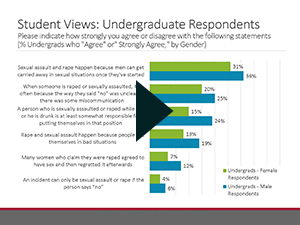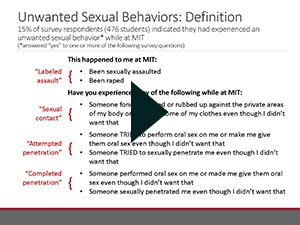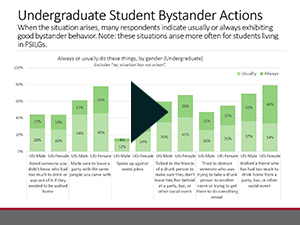Survey update from the Chancellor,
April 2015
How can you help? |
Get involved.
Support
survivors.
- Believe them.
- Be
respectful of their privacy and right to confidentiality.
- Let them make their own decisions.
- Be a good
listener.
- Offer to get them connected to resources.
| Be an active
bystander. - We should all look out for each
other.
- Notice the situation: Be aware of your
surroundings.
- Interpret it as a problem: Does someone
need help?
- Feel responsible to act: You are part of the
solution to help.
- Know what to do: Educate yourself on
how to speak up.
- Intervene safely: Take action but be
sure to keep yourself safe – enlist help if you are unsure.
|
Campus
Environment and Climate: Student Views &
Experiences |

What do the data tell us?
Survey
participants rated their level of agreement with statements
about sexual assault that are generally false, but considered
widely held. This included statements such as "A person who
is sexually assaulted or raped while she or he is drunk is at
least somewhat responsible for putting themselves in that
position." While the majority of respondents did not agree
with these statements, both undergraduate and graduate male
respondents were more likely than female respondents to agree.
When asked if they thought their peers would agree or
disagree with these statements, more were likely to indicate
their male counterparts would agree with most statements than
their female counterparts. For example, 7 out of 10
undergraduate female respondents thought that their male
counterparts would agree with the statement "When someone
is raped or sexually assaulted, it's often because the way they
said 'no' was unclear or there was some
miscommunication." What are we doing in this
area?
MIT staff and students have been developing
educational messages and a social marketing campaign to help
correct "rape myths". In addition, MIT's Infraternity
Council (IFC), in collaboration with VPR and CDSA, created
PartySafePlus trainings, designed to help students develop
skills to create a safer social environment on campus. |
Unwanted Sexual Behaviors: Incidence Rates
and Circumstances |

What do the data
tell us?
24% of female respondents and 7% of male
respondents indicated they had experienced an unwanted sexual
behavior (USB) while at MIT. Higher incidence rates were seen
among respondents who were LGBTQ, female, and affiliated with
FSILGs. Incapacitation (someone taking advantage of when the
person was too drunk, high, asleep or out of it) was the top
circumstance for incidents among all respondents.
What are we doing in this area?
MIT
has focused on increasing prevention and education efforts by:
- Building a Peer Education program focused on
sexual health
- Developing a bystander intervention and
social host program for undergraduate and graduate students
living in campus housing
- Incorporating behavioral
expectations regarding sexual assault into intervention methods
for high-risk drinkers, who are more likely to be
perpetrators
- Hosting opportunities for students to
develop creative prevention strategies utilizing their abilities
to "think outside the box" and problem-solve
- Partnering with offices who serve the LGBTQ and FSILG
community to create tailored prevention messages and
outreach
|
Unwanted Sexual Behaviors: Telling or Reporting |

What do the data tell us?
Less than two-thirds of respondents experiencing an unwanted sexual behavior told someone else about the experience, and fewer than 5% officially report it. The top four thoughts or concerns when deciding whether or not to share or report their experience were the same for students who experienced attempted or completed penetration and for those who reported sexual contact only:
- "Did not think it was serious enough to share"
- "Felt that I was at least partly at fault or it wasn't totally the other person's fault"
- "Did not want any action to be taken"
- "Not clear harm was intended"
What are we doing in this area?
- Developing a robust campaign about reporting options and resources
- Completing a review of the Committee on Discipline procedures for sexual misconduct cases and recommending a number of changes to remove barriers and improve the process for all students involved
- Forming a dedicated Title IX Office with additional staff to conduct investigations and provide training to the community
- Creating a Sexual Assault Response Team with MIT Medical, MIT Police, and the Title IX Office to coordinate efforts and regularly assess issues of campus safety
- In response to the findings of our Community Attitudes on Sexual Assault (CASA) survey, MIT has created four new positions in Violence Prevention and Response (VPR). In addition, we created a new Title IX Office, appointed a new Title IX coordinator, and hired two new staff members to address issues of gender-based inequities.
|
Prevention and Response: Bystander Actions & Resources |

What do the data tell us?
When the situation arises, many respondents indicate usually or always exhibiting good bystander behavior, especially for circumstances that involve helping a friend or someone they know. Many respondents indicated not knowing enough about key MIT resources to which they could turn if they were sexually assaulted in the future.
What are we doing in this area?
- Developing a social norms campaign to promote the bystander actions already employed and to promote behavior we would like to see increased
- Offering specialized training for key campus resources about the perception of and barriers to seeking services
- Promoting a campaign to increase awareness of resources, including short videos of service providers describing their offices, and partnering with communication experts to utilize technology to promote targeted messaging and resources
|



